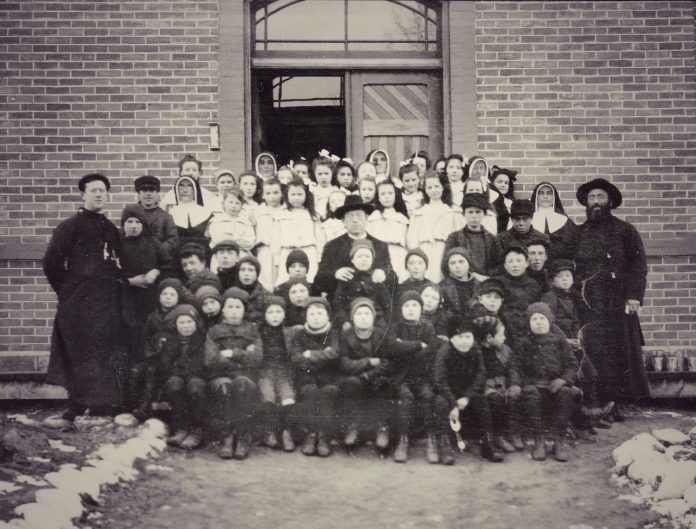
Joan Champ
This is the eighth in a series of columns about the 70 British Home Children sent to St. Patrick’s Catholic Orphanage in Prince Albert between 1901 and 1907. While all orphanage records were destroyed in the terrible fire of 1947, every attempt has been made to trace the life stories of these dispossessed children through genealogy websites and newspaper databases.
Brother Courbis and the Orphanage Farm
Now that I have introduced you to a few of the British Home Children who lived at St. Patrick’s Catholic Orphanage – and there are many more of their stories to come – I thought I would take some time to tell you what I have learned about the operations of orphanage’s farm north of Prince Albert during the early 1900s. The key figure in the operation of the farm was Brother Edouard Marie Courbis OMI (1865-1942).
Born in Vernoux, France on 27 January 1865, Brother Courbis followed Bishop Albert Pascal OMI to Canada in the fall of 1891. (OMI stands for Oblates of Mary Immaculate.) While the Bishop proceeded to Prince Albert, young Courbis entered the noviate of the Oblates at Lachine, Quebec. He professed his vows on 21 September 1892, then boarded the train for Prince Albert.
From 1895 to 1900, Brother Courbis was assigned to work at St. Michael’s, the Indian Residential School at Duck Lake. In 1900, Bishop Pascal needed help with the newly opened orphanage in Prince Albert. He sent for Brother Courbis, who at once took up residence at the orphanage.
There were a few local children in the institution but little money to sustain them. During the winter of 1900-1901 Brother Courbis contacted the authorities of the Catholic Emigration Society in England and was instrumental in bringing seventy British children to Prince Albert between 1901 and 1907. This transfer was financially motivated. In exchange for assuming responsibility for the children, the orphanage was paid $11,000. This money was used to add two wings to the orphanage building.
Funds were still needed for day-to-day operations. Brother Courbis strongly believed that a farm would set St. Patrick’s Orphanage on a self-sustaining financial footing. In 1903-04, he set up farming operations in the White Star district. (White Star was originally named Édouardville or, Edwardfield, after Brother Édouard Courbis.) His theory was that farm animals, hay meadows, a vegetable garden, and trees for firewood would provide daily produce for the institution. Wheat, oats, and barley would provide annual revenue.
Two sections of land were purchased and two sections were leased from the federal government for the orphanage by the Roman Catholic Episcopal Corporation of Saskatchewan. The Ministry of the Interior stipulated in the lease agreements for Section 6, Twp 50, Range 26, W2 and east half of 36-49-27 W2 (later switched with north quarter 31-49-26 W2) that the orphanage was required “to continuously maintain and operate a school of instruction in practical farming and all matters pertaining thereto which school shall have an average attendance of thirty pupils at least, the whole to the satisfaction of the Ministry.”
On April 12, 1905, Metis scrip #11870, originally issued on 25 October 1900 to James Isbister (sole heir to George Isbister), was used by St. Patrick’s as partial payment on 5-50-26 W2. In the late 1800s, scrip was used to extinguish Métis Aboriginal land title, much as treaties did for First Nations. In many cases, Métis lost their scrip lands to unscrupulous speculators for a fraction of their value. Correspondence in the homestead files from the Provincial Archives of Saskatchewan shows that Father Brueck purchased several Metis scrip notes to make partial payments on land for the orphanage farm.
Once the St. Patrick’s boys finished their schooling at Grade 8, Brother Courbis had them work on the farm. According to Buckland’s Heritage (1980), the boys lived together “in a large, communal house, were fed at a long narrow table and bedded down on the floor in places that were assigned to each.”
The orphanage farm took work contracts and the boys earned wages around the district. For example, the local history book Buckland’s Heritage records that Brother Courbis contracted to build the portion of the old highway from the Prince Albert Industrial Park to the old bridge over the North Saskatchewan River at Prince Albert. “Men, boys and horses drawing ‘slips’ and other equipment toiled through the muskeg,” the book states. “It is said the total paid for the contract was $1000, wages of $1.00 per day and $5.00 per working outfit of horses and a piece of equipment.” In the winter of 1910-11, the RCMP paid Brother Courbis $336.47 for firewood.
[Sessional papers of the Dominion of Canada 1912, Auditor General’s Report.]
Brother Courbis was anxious to have each of the boys secure a homestead as soon as they were eligible, but he did not want the boys leave his charge until they were at least 21 years old and able to shift for themselves. After leaving the orphanage, several boys obtained their own farmland under the Homestead Land Grant System with assistance from Courbis.
Despite his best efforts to make the orphanage farm a success, Brother Courbis ran into many setbacks. For example, a wildfire in the spring of 1908 destroyed fifty tons of the farm’s hay. [Saskatoon StarPhoenix, 12 May 1908] The farm operation did not yield the results he had hoped for, and the enterprise was abandoned in 1911. Courbis was devastated. According to Father Brueck’s account in Monica Plante’s 1988 history of the orphanage, he severed his connections with the orphanage in Prince Albert and went to worked at several Indian Residential schools in Alberta and BC. He eventually returned to St. Patrick’s orphanage in 1926 where he remained until he died at age 77 on 5 February 1942.

